DTC P0974 3.6L

Circuit Description
The 1-2 shift solenoid (1-2 SS) valve controls transmission fluid pressure acting on the 1-2 shift valves to position the valves for the appropriate gear. The 1-2 SS valve is a normally-open exhaust valve located on the control valve body. A fused circuit supplies ignition voltage to the 1-2 SS valve. The transmission control module (TCM) commands the solenoid ON or OFF by switching the ground path. When the 1-2 SS valve is commanded ON, the TCM senses low voltage. When the 1-2 SS valve is commanded OFF, the TCM senses high voltage. Refer to Shift Solenoid Valve State and Gear Ratio .
If the TCM detects a short to voltage in the 1-2 SS valve circuit, then DTC P0974 sets. DTC P0974 is a type B DTC.
DTC Descriptor
This diagnostic procedure supports the following DTC:
DTC P0974 1-2 Shift Solenoid (SS) Control Circuit High Voltage
Conditions for Running the DTC
The ignition is ON.
Conditions for Setting the DTC
The TCM detects a short to voltage in the 1-2 SS valve control circuit for 4.4 seconds.
Action Taken When the DTC Sets
| • | The TCM requests the ECM to illuminate the malfunction indicator lamp (MIL) during the second consecutive trip in which the Conditions for Setting the DTC are met. |
| • | The TCM commands maximum line pressure. |
| • | The TCM commands an alternate coast shift pattern where downshifts occur at higher vehicle speeds while coasting. |
| • | The TCM freezes transmission adaptive function. |
| • | The TCM records the operating conditions when the Conditions for Setting the DTC are met. The TCM stores this information as Freeze Frame and Failure Records. |
| • | The TCM stores DTC P0974 in TCM history during the second consecutive trip in which the Conditions for Setting the DTC are met. |
Conditions for Clearing the MIL/DTC
| • | The ECM turns OFF the MIL after the third consecutive trip in which the TCM does not send an MIL illumination request. |
| • | A scan tool can clear the MIL/DTC. |
| • | The TCM clears the DTC from TCM history if the vehicle completes 40 warm-up cycles without an emission-related diagnostic fault occurring. |
| • | The TCM cancels the DTC default actions when the ignition switch is OFF long enough in order to power down the TCM. |
Diagnostic Aids
Ensure the wiring harness is not stretched too tightly or other components are pressing on the A/T inline 20-way connector body. Also inspect for proper clearance to any other components and wiring. Refer to Testing for Intermittent Conditions and Poor Connections .
Test Description
The numbers below refer to the step numbers on the diagnostic table.
-
This step tests the TCM and the wiring to the transmission.
-
This step verifies that the circuit has the correct resistance.
Step | Action | Value(s) | Yes | No |
|---|---|---|---|---|
1 | Did you perform the Diagnostic System Check - Vehicle? | -- | Go to Step 2 | |
2 |
Important: Before clearing the DTC, use the scan tool in order to record the Freeze Frame and Failure Records. Using the Clear Info function erases the Freeze Frame and Failure Records from the TCM. Does the scan tool display indicate a short to voltage? | -- | Go to Step 3 | Go to Testing for Intermittent Conditions and Poor Connections |
Refer to Automatic Transmission Inline 20-Way Connector End View . Is the test lamp ON? | -- | Go to Step 4 | Go to Step 5 | |
4 | Test the control circuit of the 1-2 SS valve for a short to voltage between the TCM connector and the AT inline 20-way connector. Refer to Testing for a Short to Voltage and Wiring Repairs . Did you find and correct the condition? | -- | Go to Step 10 | Go to Step 9 |
Refer to Automatic Transmission Inline 20-Way Connector End View . Is the resistance less than the specified value? | 19 ohms | Go to Step 6 | Go to Testing for Intermittent Conditions and Poor Connections | |
6 |
Is the resistance less than the specified value? | 19 ohms | Go to Step 7 | Go to Step 8 |
7 | Replace the automatic transmission wiring harness. Refer to Wiring Harness Replacement . Did you complete the replacement? | -- | Go to Step 10 | -- |
8 | Replace the 1-2 SS valve. Refer to 1-2 Shift Solenoid Valve Replacement . Did you complete the replacement? | -- | Go to Step 10 | -- |
9 | Replace the TCM. Refer to Control Module References for replacement, setup and progamming. Did you complete the replacement? | -- | Go to Step 10 | -- |
10 | Perform the following procedure in order to verify the repair:
Has the test run and passed? | -- | Go to Step 11 | Go to Step 2 |
11 | With the scan tool, observe the stored information, capture info. and DTC info. Does the scan tool display any DTCs that you have not diagnosed? | -- | System OK |
